Ecosystem class 12 Notes Biology in PDF are available for free download in myCBSEguide mobile app. The best app for CBSE students now provides Ecosystem class 12 Notes latest chapter wise notes for quick preparation of CBSE board exams and school-based annual examinations. Class 12 Biology notes on chapter 14 Ecosystem are also available for download in CBSE Guide website.
CBSE Guide Ecosystem class 12 Notes Biology
CBSE guide notes are the comprehensive notes which covers the latest syllabus of CBSE and NCERT. It includes all the topics given in NCERT class 12 Biology textbook. Users can download CBSE guide quick revision notes from myCBSEguide mobile app and my CBSE guide website.
Class 12 Biology notes Chapter 14 Ecosystem
Download CBSE class 12th revision notes for chapter 14 Ecosystem in PDF format for free. Download revision notes for Ecosystem class 12 Notes and score high in exams. These are the Ecosystem class 12 Notes prepared by team of expert teachers. The revision notes help you revise the whole chapter 14 in minutes. Revision notes in exam days is one of the best tips recommended by teachers during exam days.
Download Revision Notes as PDF
CBSE Class 12 Biology Revision Notes Chapter 14 Ecosystem
Ecosystem is the functional unit of nature where living organisms interact among themselves and also with the surroundings physical environment.
Ecosystem- Structure and Functions
Ecosystem : There are two basic categories of ecosystem , namely the terrestrial and the aquatic.
Terrestrial ecosystem – forest, grassland , desert etc.
Aquatic ecosystem – ponds, lake, river estuary etc.
The biotic and abiotic factors of ecosystem work in integrated manner for flow of energy within the components of ecosystem. Interaction of biotic and abiotic components results in a physical structure that is characteristic for each type of ecosystem. The vertical distribution of different species occupying different levels is called stratification.For example, trees occupy top vertical strata or layer of a forest, shrubs the second and herbs and grasses occupy the bottom layers.
The components of ecosystem that are seen as functional unit are
(i) Productivity
(ii) Decomposition
(iii) Energy flow
(iv) Nutrient cycling.
· Productivity- Primary production is defined as the amount of biomass or organic matter produced per unit area over a time period by plants during photosynthesis. It is expressed in terms of weight (g –2 ) or energy (kcal m–2 ). The rate of biomass production is called productivity. It is expressed in terms of g –2 yr –1 or (kcal m–2 ) yr –1. It can be divided into gross primary productivity (GPP) and net primary productivity (NPP). GPP of an ecosystem is the rate of production of organic matter during photosynthesis and NPP is the remaining biomass after respiration (R).
GPP –R = NPP
NPP is the available biomass for consumption to heterotrophs. Secondary productivity is defined as the rate of formation of new organic matter by consumers.
Decomposition- breakdown of complex organic matter into inorganic substances like carbon dioxide, water and nutrients is called decomposition. Dead plants remains like leaves, bark, flowers and dead remains of animals constitute detritus. Decomposition involves following steps- fragmentation, leaching, catabolism, humification and mineralization.
- Fragmentation of Detritus: Detritivores feed on detritus —breakdown — increases the surface area of detritus particles for microbial action.
- Leaching: Soluble inorganic nutrients dissolve in water -– percolate through the soil —removed due to leaching action.
- Catabolism: Decomposers (bacteria, fungi) release enzymes — decompose detritus — simpler inorganic compounds.
- Humification: Simplified detritus— converted to humus
– Humus is a Dark, Amorphous substance.
– Highly resistant to Microbial Action
– Undergoes Decomposition very Slowly.
– Reservoir of nutrients (due to colloidal nature)
5. Mineralisation: Humus is degraded – releases inorganic substances
( CO2, H2O etc) and nutrients (Ca2+, Mg2+,K+ etc)
Factors affecting rate of Decomposition:
1. Chemical composition – decomposition rate will be slow when detritus is rich in lignin and chitin and rate increases when detritus is rich in nitrogen and water soluble substances like sugars.
2. Climatic conditions – warm and moist environment favour decomposition and low temperature and anaerobiosis inhibit decomposition.
Energy Flow- All living organisms are dependent for their food on producers, directly or indirectly. There is a unidirectional flow of energy from the sun to producers and then to consumers. Photosynthetically active radiation (PAR) is responsible for synthesis of food by plants. Animals obtain their food from plants, so they are called consumers. The process of eating and being eaten is called food chain in which energy flow from producers to consumers. In Grazing food chain (GFC)-

The detritus food chain begins (DFC) begins with dead organic matter. It is made up of decomposers which are heterotrophic organisms (fungi and bacteria). These are also known as saprotrophs (sapro: to decompose). Decomposers secrete digestive enzymes that breakdown dead and waste materials into simple, inorganic materials, which are subsequently absorbed by them.Natural interconnection of food chain forms the food web.
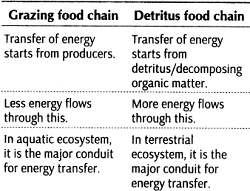
Based on source of food, organism occupies a specific place in food chain that is known as trophic level.
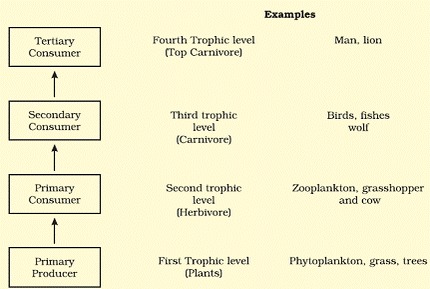
Each tropic level has a certain mass of living material at particular time called as standing crop. It is measured as biomass of living organism or number in unit area.
The number of trophic levels in the grazing food chain is limited as the transfer of energy follows 10 percent law that is only 10 percent of the energy is transferred to each trophic level from the lower trophic level. In GFC, following trophic levels are possible- producer, herbivore, primary carnivore, secondary carnivore.
Ecological Pyramids
Ecological pyramid is the graphical representation of an ecological parameter (number, biomass, energy) sequence wise in various trophic levels of a food chain with producers at the base and herbivores in the middle and carnivores at the top tiers. It can be upright, inverted, or spindle shaped.

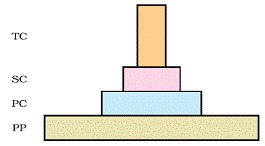
Three common ecological pyramids are
a) Pyramids of number- employs the number of individuals per unit area at various trophic levels with producer at base and various consumers at successively higher levels. It is generally upright.
A pyramid of number in case of a big tree is generally inverted because number of insects feeding on that tree generally exceeds in number.
b) Pyramids of biomass- represent the biomass in various trophic levels. A pyramid of mass is upright except in aquatic food chain involving short lived plankton.
A pyramid of biomass in sea is generally inverted because biomass of fishes generally exceeds that of phytoplankton.


c) Pyramids of energy- that give s graphic representation of amount of energy trapped by different trophic levels per unit area. Pyramid of energy is always upright, can never be inverted, because when energy flows from a particular trophic level to the next trophic level, some energy is always lost as heat at each step e.g in feeding, digestion, assimilation and respiration.
Ecological Succession
The gradual and fairly predictable change in species composition of a given area is called ecological succession. During succession some species colonise an area and their population becomes more numerous whereas population of other species decline and even disappear.
· Orderly and sequential change that leads to a community that is near equilibrium is called climax community.
· The entire sequence of communities that successively changes in a given area is called sere and individual transitional communities are termed seral stage or seral communities.
Ecoloical Succession : Primary sucsesion, Secondary Succession
· Primary succession starts where no organism are there. For example bare rocks, cooled volcano etc. Secondary succession occurs in the area where the living organisms have lost due to certain regions like forest fire. Earthquake etc.
Succession of Plants
On the basis of nature of habitat, succession of plants can be grouped as-
o Hydrach succession takes place in wetter area and the successional series progress from hydric to the mesic conditions.
o Xerarch succession takes place in dry areas and series progress from xeric to mesic conditions.
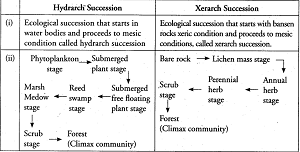
· The species that invade a bare area are called pioneer species. In primary succession on rocks lichens are pioneer species that secrete acids to dissolve the rock for weathering to form soil.
· In primary succession in water, the pioneer species are the small phytoplanktons that are replaced by free floating angiosperms.
· Primary succession is slow process as soil is not available for pioneer species but secondary succession is comparatively faster due to availability of soil or other nutrients. A climax community is reached much faster in case of secondary succession.
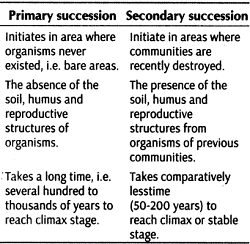
Nutrient Cycling
The movement of nutrients elements through the various components of an ecosystem is called nutrient cycling. It is also called as biogeochemical cycles. There are two types of nutrient cycles-
· Gaseous – exist in atmosphere.
· Sedimentary- exists in earth crust.
Environmental factors like soil, moisture, pH, temperature regulate the rate of release of nutrients into the atmosphere. The function of reservoir is to meet with the deficit which occurs due to imbalance in the rate fo influx and efflux.
Carbon Cycle
Carbon cycling occurs through atmosphere, ocean and through living and dead organisms. Most of carbon is fixed by plants during the process of photosynthesis and returns to atmosphere in form of CO2 during respiration. Burning of wood, forest fire and combustion of organic matter, fossil fuel, and volcanic activity are other sources of releasing CO2 in the atmosphere.
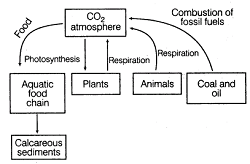
Phosphorus Cycle
The natural reservoir of phosphorus is rock which contains phosphorus in the form of phosphates. On weathering, minute amount of phosphates dissolve in soil solution and absorbed by the roots of the plants. The waste products of dead organisms are decomposed by bacteria to release phosphorus. Gaseous exchange between organism and environment is negligible as compared to carbon.

Phosphorus Cycle
Ecosystem Services
The products of ecosystem processes are called ecosystem services. It includes-
· The healthy forest ecosystem purify air and water
· Mitigates floods and droughts
· Cycle nutrients
· Generate fertile soil
· Provide wildlife habitat
· Maintain biodiversity etc.
Researchers have put an average price tag of US $33 trillion a year on these fundamental ecosystems services which are taken granted because they are free although its value is twice the total global gross national product (GNP).
Ecosystem class 12 Notes Biology
- CBSE Revision notes (PDF Download) Free
- CBSE Revision notes for Class 12 Biology PDF
- CBSE Revision notes Class 12 Biology – CBSE
- CBSE Revisions notes and Key Points Class 12 Biology
- Summary of the NCERT books all chapters in Biology class 12
- Short notes for CBSE class 12th Biology
- Key notes and chapter summary of Biology class 12
- Quick revision notes for CBSE board exams
CBSE Class-12 Revision Notes and Key Points
Ecosystem class 12 Notes Biology. CBSE quick revision note for class-12 Chemistry Physics Math’s, Biology and other subject are very helpful to revise the whole syllabus during exam days. The revision notes covers all important formulas and concepts given in the chapter. Even if you wish to have an overview of a chapter, quick revision notes are here to do if for you. These notes will certainly save your time during stressful exam days.
- Physics
- Chemistry
- Mathematics
- Biology
- Accountancy
- Economics
- Business Studies
- Computer Science
- Informatics Practices
- English Core
- History
- Physical Education
To download Ecosystem class 12 Notes Biology sample paper for class 12 Physics, Chemistry, Biology, History, Political Science, Economics, Geography, Computer Science, Home Science, Accountancy, Business Studies and Home Science; do check myCBSEguide app or website. myCBSEguide provides sample papers with solution, test papers for chapter-wise practice, NCERT Ecosystem, NCERT Exemplar Ecosystem, quick revision notes for ready reference, CBSE guess papers and CBSE important question papers. Sample Paper all are made available through the best app for CBSE students and myCBSEguide website.
- Reproduction in Organisms class 12 Notes Biology
- Sexual Reproduction in Flowering Plants class 12 Notes Biology
- Human Reproduction class 12 Notes Biology
- Reproductive Health class 12 Notes Biology
- Principles of Inheritance and Variation class 12 Notes Biology
- Molecular Basis of Inheritance class 12 Notes Biology
- Evolution class 12 Notes Biology
- Human Health and Disease class 12 Notes Biology
- Strategies for Enhancement in Food Production class 12 Notes Biology
- Microbes in Human Welfare class 12 Notes Biology
- Biotechnology Principles and Processes class 12 Notes Biology
- Biotechnology and its Applications class 12 Notes Biology
- Organisms and Populations class 12 Notes Biology
- Biodiversity and Conservation class 12 Notes Biology
- Environmental Issues class 12 Notes Biology

Test Generator
Create question paper PDF and online tests with your own name & logo in minutes.
Create Now
Learn8 App
Practice unlimited questions for Entrance tests & government job exams at ₹99 only
Install Now